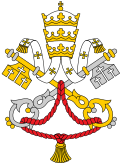当选教宗斯德望
外观
此條目需要补充更多来源。 (2019年10月3日) |
| 當選教宗 德範 Electus Stephanus PP. | |
|---|---|
 | |
| 就任 | 752年3月23日 |
| 卸任 | 752年3月26日 |
| 前任 | 聖匝加 |
| 繼任 | 德範二世 |
| 個人資料 | |
| 本名 | 德範 |
| 逝世 | 752年3月26日 羅馬 |
教宗當選者德範(拉丁語:Electus Stephanus PP.;?—752年3月25日)本名不詳,是752年3月23日當選教宗的羅馬神父,為聖匝加的繼位者。其在位三天(或四天)後中風猝逝,成為歷任教宗在位最短者[1][2],因生前未及接受主教祝圣儀式,许多天主教歷史書籍因而不視他為教宗,稱下任同名教宗為德範二世。
745年,聖匝加提拔他為聖基所恭聖殿領銜堂區的樞機,該堂區後由樞機弗雷德里克(英語:Cardinal Frederick of Lorraine)接任,後者後來成為教宗德範九世。
《宗座年鑑》中提到其「繼任者」德範二世(三世)時,註釋道:「聖匝加死時,羅馬神父德範被選為新教宗,但由於他隔四天後便死亡,未及參加他的主教祝圣儀式,根據《天主教法典》此時其任職才真正生效,因此其姓名沒有登記在宗座書籍上,亦不見於其他教宗列表。」[3]
752年到942年,共有八位名為德範的教宗(包括本條目者),但僅七位有實際統治。十世紀前教宗無統治序數,彼時附於名後的編號皆屬追認。當在名後附加編號成為慣例後,首位自號為德範者為德範九世,他一生均以「教宗德範九世(Stephanus Papa Nonus)」署明文件。
直到1975年10月1日的教會法[4]都還視當選當下即為就任,因此本條目之德範在1961年被自《宗座年鑑》移除前,曾被編序為二世,有些作者從而把其後所有同名教宗編號增加一位,由德範二至九世被序稱為三至十世[5],這種編號的分歧見於《天主教百科全書》[6]、《宗座年鑑》[3]以及《大英百科全書》[7]。在1996年2月22日,教宗若望保祿二世頒布的憲令(第89款)規定:「若當選者尚非主教...只有在其被祝聖為主教後,才得宣佈其當選」,方解決此類紛爭。
參見
[编辑]參考資料
[编辑]- ^ Horace Mann, "Pope Stephen II" in Catholic Encyclopedia (New York 2013). [2015-09-01]. (原始内容存档于2012-06-22).
- ^ History's great untold stories: larger than life characters & dramatic ... (页面存档备份,存于互联网档案馆) By Joseph Cummins. National Geographic Books. p. 13.
- ^ 3.0 3.1 Annuario Pontificio 2012 (Libreria Editrice Vaticana 2012 ISBN 978-88-209-8722-0), p. 11*
- ^ On that date, Pope Paul VI changed the law, laying down in his apostolic constitution Romano Pontifici eligendo (页面存档备份,存于互联网档案馆) that (to quote an English version of the document (页面存档备份,存于互联网档案馆)), "88. After his acceptance, the person elected, if he be a bishop, is straightway bishop of Rome, true pope, and head of the episcopal college. He possesses and can exercise full and supreme power over the universal Church. If, however, the elected person does not possess the episcopal character, he is to be immediately ordained a bishop." Pope Paul VI's change of the law was incorporated into the 1983 Code of Canon Law (页面存档备份,存于互联网档案馆): "Can. 332 §1 The Roman Pontiff acquires full and supreme power in the Church when, together with episcopal consecration, he has been lawfully elected and has accepted the election. Accordingly, if he already has the episcopal character, he receives this power from the moment he accepts election to the supreme pontificate. If he does not have the episcopal character, he is immediately to be ordained Bishop."
- ^ Richard P. McBrien, Lives of the Popes (Harper Collins 2013 ISBN 978-0-06228834-9), p. 121. [2015-09-01]. (原始内容存档于2016-09-22).
- ^ For instance, Pope Stephen II (III) (页面存档备份,存于互联网档案馆)
- ^ Encyclopaedia Britannica, 14 pages in volume 17. [2015-09-01]. (原始内容存档于2016-03-22).

